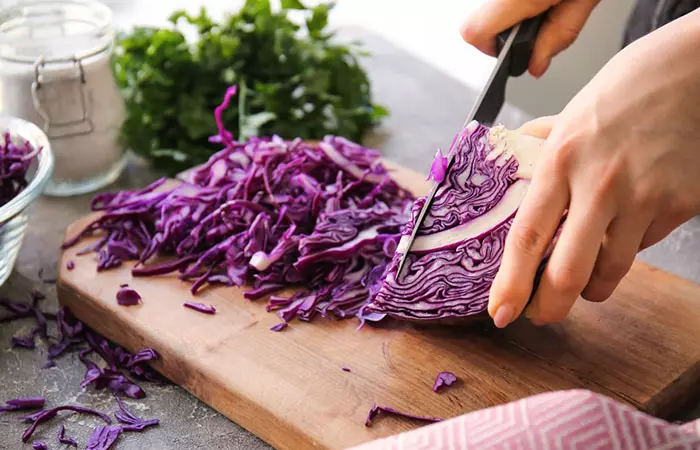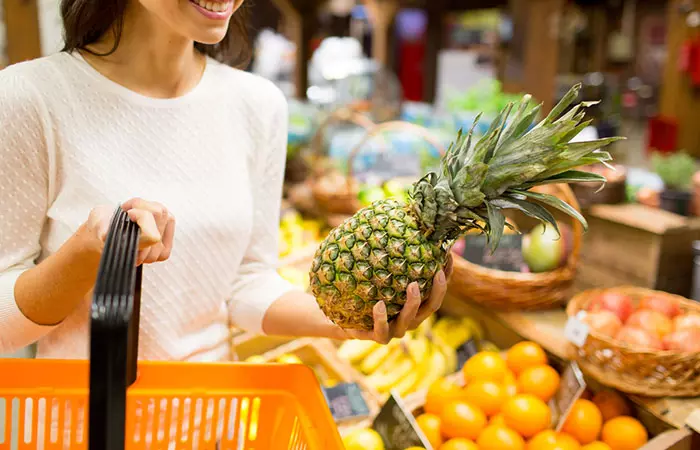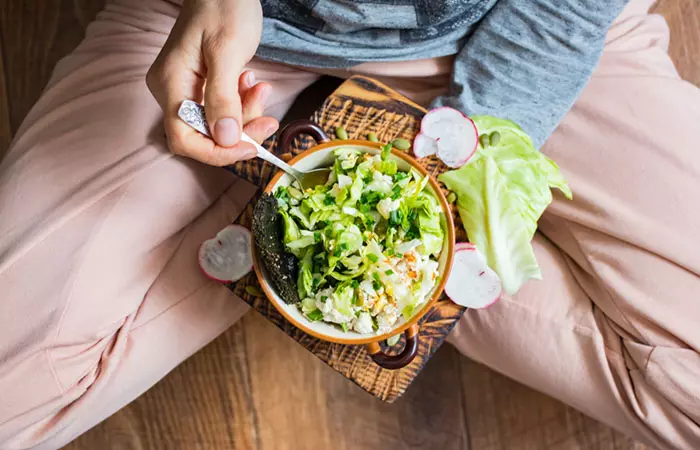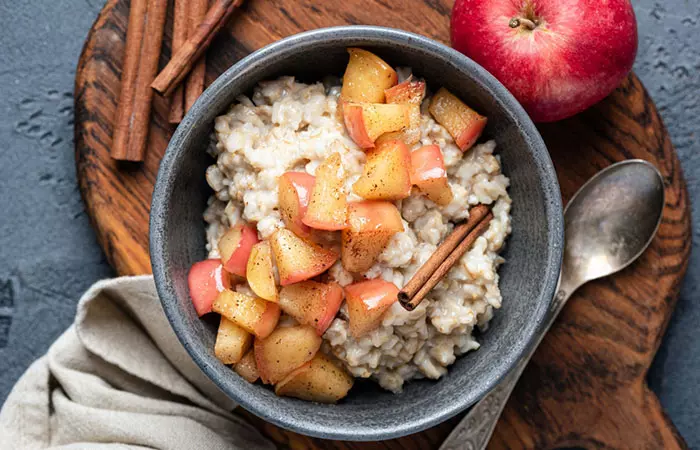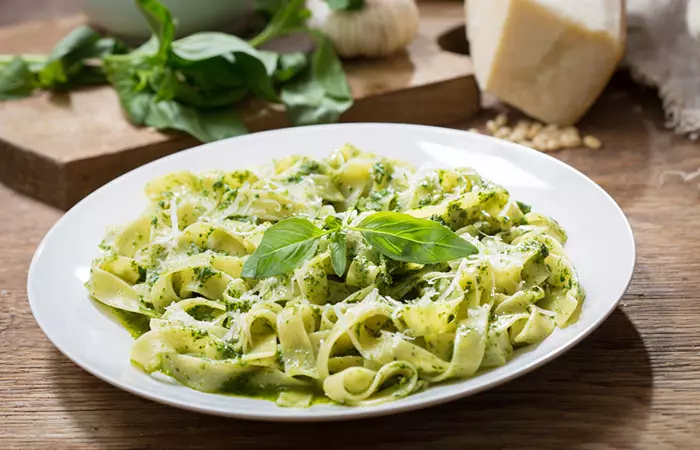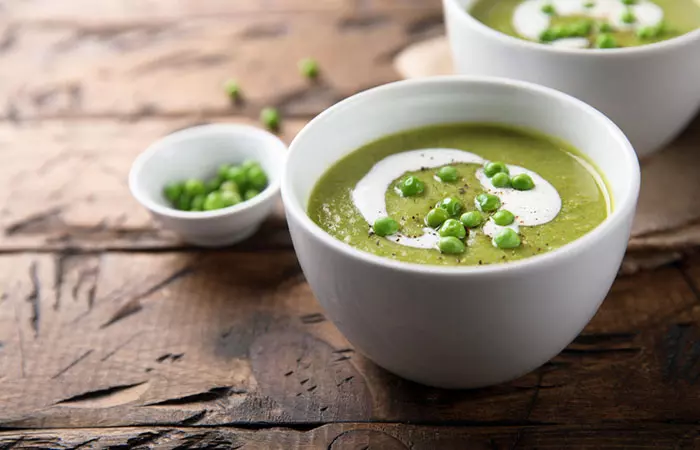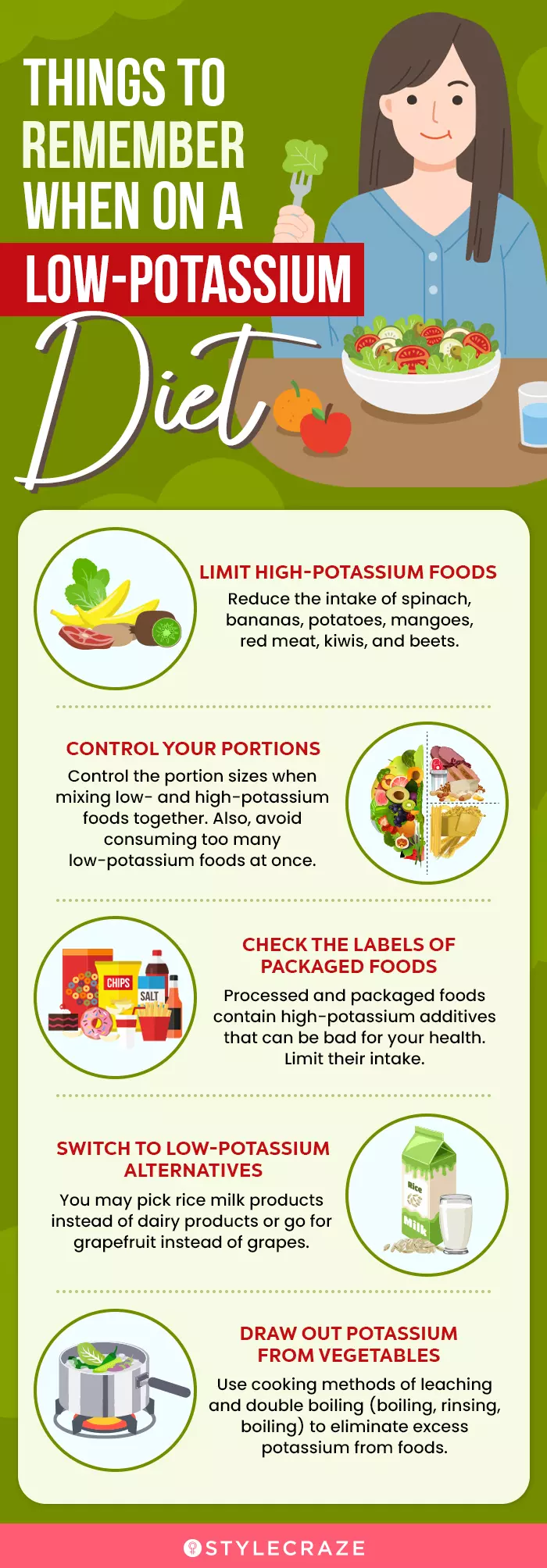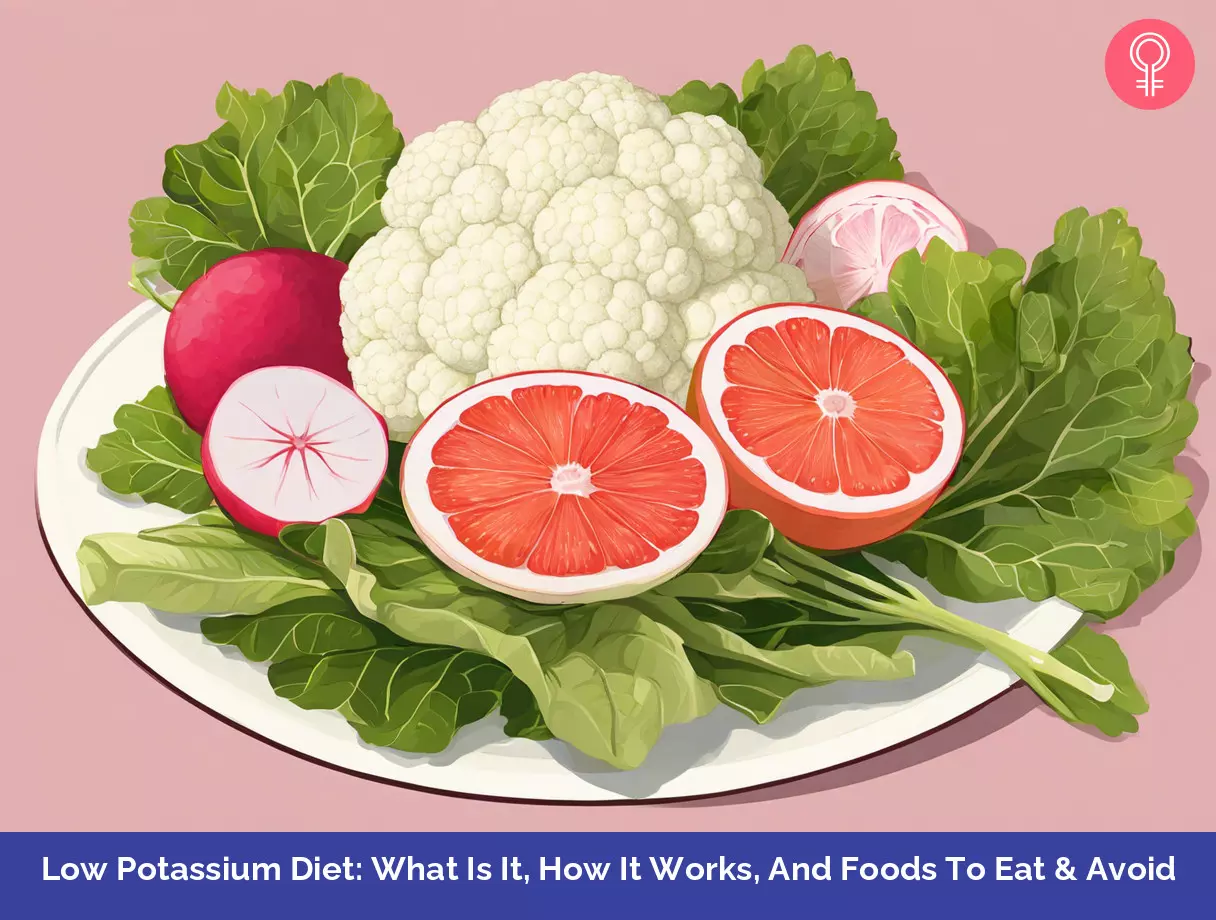What Is A Low-Potassium Diet?
A low-potassium diet involves consuming foods that contain low levels of potassium to avoid overdose. According to the US National Academy of Sciences, the recommended daily intake of potassium for healthy adults is 3,400 mg per day for men and 2600 mg per day for women. For those who have high blood potassium levels (hyperkalemiai A medical condition caused by an increase of potassium levels in the bloodstream, leading to cardiac and muscle problems. ) and chronic kidney disease, it is limited to 2,000 mg per day (2). In extreme cases of kidney disease, the recommended potassium intake may need to be reduced to 1,500 mg per day or even lower (3). Limiting potassium intake is crucial because high potassium levels in the blood may lead to (4), (5):
Cold skin Mental confusion Drowsiness Muscle tiredness, cramps, weakness Lightheadedness or nausea Palpitations Paralysis
Since going on a low-potassium diet means you have to exclude or limit the intake of many healthy and nutritious fruits and vegetables, it’s important to consult a doctor and follow the recommended diet plan to avoid the risk of deficiencies. Keeping the dietary potassium at healthy levels improves bodily functions and protects you from various health issues. Let’s understand how it helps and things to keep in mind while following the low-potassium diet.
Low-Potassium Diet: How It Works And Tips To Follow
A low-potassium diet adheres to the following principles:
Limiting High-Potassium Foods
It focuses on reducing the intake of dietary fiber by allowing moderate to no consumption of high-potassium foods. These foods include spinach, bananas, potatoes, mangoes, red meat, kiwis, beets, etc. (5)
Controlling Portion Sizes
Consuming too many low-potassium foods at once may still increase your potassium intake. Therefore, it is crucial to plan your meals carefully and watch your portions when on a low-potassium diet. Similarly, reduce the portion size of high-potassium foods to maintain healthy potassium levels in your meals.
Avoiding High-Potassium Additives
Processed and packaged foods are loaded with additives such as potassium chloride (6). Read the labels carefully and limit the quantity of processed foods in your diet when on a low-potassium diet.
Selecting Low-Potassium Alternatives
Consuming foods with a lower potassium content and choosing low-potassium alternatives to certain foods may help you eat more without overdosing on this mineral. For example, you may choose white rice instead of brown rice or grapefruit instead of grapes (7).
Trying Effective Cooking Methods
Leaching is the most common technique that may draw out potassium from root vegetables such as potatoes. It involves slicing and soaking the vegetables in water overnight, followed by draining and boiling the vegetables in new water (8). However, compared to leaching, boiling the foods may significantly reduce potassium content. A study published by the National Library Of Medicine suggests that cutting vegetables into smaller pieces or shredding them before boiling helps remove a lot more potassium compared to just leaching (9). Another study suggests that the double cooking method (boiling, rinsing, and boiling again) is more effective in drawing out maximum potassium from tuberous root vegetables (10). All these techniques are highly effective and may help you reduce and optimize potassium levels in your diet. Consult a registered dietitian to finalize the personalized measures for maintaining the required level of potassium in your diet. They can recommend some healthy low-potassium foods to choose from. Your doctor may also prescribe diureticsi Medications that increase urine production and help get rid of the excess fluid and salt from the body. and potassium bindersi Medications that help remove excess potassium from the bloodstream in individuals with hyperkalemia. to bring your potassium levels under control (11), (12). This excess potassium is then passed through urine and stool. However, prevention is better than cure, and your diet plays a huge role in managing hyperkalemia. In the case of a potassium overdose, you may need certain low-potassium foods that can help regulate the potassium levels. Check out the next sections to learn more about foods to eat and avoid.
Low-Potassium Diet: Foods To Eat And Avoid
Foods To Eat
Vegetables Here is the list of low-potassium vegetables that you may eat (14), (15):
Green peas Cauliflower Corn (sweet yellow) Parsnip Green onion Iceberg lettuce Radish Cucumber Green cabbage Leaf lettuce
Fruits Here are some fruits that are low in potassium (16), (17):
Apples Strawberries Tangerines Pineapple Pear Lime Lemon Grapefruit Honeydew melon
Other Low-Potassium Foods Check out some foods that are low in potassium (18), (19), (20):
Rice milk Egg whites White rice Toasted bread Pasta Corn Flakes
Foods To Avoid
Vegetables Here are some vegetables that you need to avoid or consume in moderation (1), (15), (21):
Dried beans and peas Brussel sprouts Spinach Sweet potato Asparagus Broccoli Celery Cauliflower Mushroom Potatoes Sweet potatoes Tomatoes Beet greens Carrot White beans
Fruits And Dried Fruits
Avoid these fruits to prevent spikes in potassium levels (1), (17), (21):
Sweet cherries Watermelon Plums Nectarines Oranges Avocado Dried apricots Dates Kiwifruit Prune Grapes Cantaloupe
Other High-Potassium Foods Watch your portion sizes when consuming the following foods as they contain high levels of potassium (14), (21):
Dairy products (cheese, milk, ice cream, yogurt) Organ meats, liver Dark colas/sodas Oysters Sardines Yogurt Chocolate Bran cereals and oatmeal, whole grain products Nuts and nut butters Egg yolks Salmon Pork chop Cod
Comparison of potassium content in commonly consumed fruits
This list of low-potassium foods may be very restrictive, but you may still enjoy a variety of medium or high-potassium foods by carefully selecting the portions. We have shared a sample low-potassium diet plan below to help you plan your meals. However, this is just for reference. It is best to consult a certified dietitian to decide your meal size and ingredients. Scroll down.
Sample Low-Potassium Diet Plan
Following this detailed diet plan will help you keep your potassium levels in check. Remember to watch your portions or you may end up getting too much potassium. Following a low-potassium diet need not be boring. You can still enjoy hearty and flavorful meals. Check out the next section for recipe ideas.
Low-Potassium Diet Recipes
Breakfast Recipes
1. Spiced Porridge And Stewed Apples
Ingredients
40g of oats 200 mL of skimmed milk ½ teaspoon of cinnamon A pinch of allspice 1 apple (diced or sliced) 2 teaspoons of water
How To Prepare
2. Haddock And Lettuce Kedgeree
Ingredients
1 onion 1 tablespoon of olive oil 1 teaspoon of turmeric ½ teaspoon of curry powder 2 garlic cloves (crushed and chopped) 500g ready-to-cook rice A large ladleful of low-salt vegetable stock 2 filets of haddock (cut into pieces) A handful of green lettuce (blanched and torn into pieces) Fresh parsley for garnish
How To Prepare
Dinner Recipes
1. Basil Pesto Pasta
Ingredients
250g of dry pasta 2 cloves of garlic (paste) 1/4 cup parmesan cheese (shredded) 2 cups of freshly chopped basil 2 tablespoons of olive oil 1/4 cup of pine nuts (chopped)
How To Prepare
2. Crispy Corn Fritters
Ingredients
2 cups of corn 1/2 cup of white flour 1/3 cup of rice milk 1/4 teaspoon of garlic powder 2 teaspoons of sugar 1/4 teaspoon of baking soda 2 tablespoons of vegetable oil 1/8 teaspoon of salt 1/4 teaspoon of black pepper 1 egg (lightly beaten)
How To Prepare
Soup Recipes
1. Creamy Green Pea Soup
Ingredients
1 tablespoon of olive oil 1 red onion (diced) 1 green onion greens (chopped) 2 cloves of garlic ½ cup of green peas 1 cup of vegetable stock (made with some cabbage, lettuce, and radish) 1 tablespoon of heavy cream Salt and black pepper to taste
How To Prepare
2. Corn Soup
Ingredients
1 tablespoon of olive oil 2 teaspoons of garlic (minced) ½ sweet onion (chopped) 1 cup of sodium-free chicken stock ½ head of green cabbage (shredded) ¼ carrots (diced) 6 cups of water ¼ cups of corn 2 pinches of black pepper powder 2 tablespoons of fresh thyme (chopped)
How To Prepare These lip-smacking recipes are a healthy option for those on a low-potassium diet. Please note that these recipes also include some high-potassium ingredients, which are safe to consume in a moderate quantity. However, always consult a dietitian for personalized dietary recommendations and portion sizes. Is brinjal high in potassium? Brinjal or eggplant is not high in potassium as 100 g of brinjal contains 229 mg of potassium (22). Is curd high in potassium? No, the curd is a low-potassium food as 100 g of curd contains only 137 mg of potassium (23). Are almonds high in potassium? Yes. Almonds are a rich source of potassium. A hundred grams of almonds contain 733 mg of potassium (24). How can I check my potassium level at home? You can not check your potassium level at home. Correct potassium levels can be checked only through a blood or urine test. Can high potassium cause leg cramps? Yes. A study suggests that overdosing on potassium potassium may cause leg cramps or muscle cramps (25). What are the symptoms of high potassium in the elderly? High potassium levels in the elderly may lead to life-threatening symptoms such as irregular heartbeat, muscle weakness, or paralysis (5). Elderly people with chronic hyperkalemia may remain asymptomatic. However, those experiencing sudden spikes in potassium levels may develop severe symptoms such as palpitations, drowsiness, cold skin, mental confusion, and a fall in blood pressure (4). Does watermelon have potassium? Yes, 100 g of watermelon contains about 270 mg of potassium (17).
Illustration: Low Potassium Diet: What Is It How It Works And Foods To Eat & Avoid
Cooking vegetables through the process of leaching and boiling can reduce their potassium levels. Check out the following video to learn how to cook potatoes and vegetables for a low-potassium diet.
